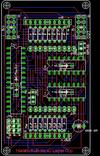EAGLE is probably the most common software used for PCB creation. Many years ago I saw a professional using it on DOS. Looked good and not simple at all. Back then creating PCBs was quite expensive too, so I never thought about making them myself. For most of my purposes a breadboard works well enough. For a bit more permanent things I have those which is just the same layout and connections, but for soldering.
For a bit more complex things though the problems of breadboards become an issue:
Distressing as it may sound, solderless breadboards can be very flakey, especially as they age. If you’re having problems with your circuit, it could be that the little metal clips on the inside aren’t working well. Try poking it with your finger, or moving it to a different section.
It’s still great for small tests, but for permanent things, expect a low reliability.
Anyway, for a large clock using those quite large 16 segment LEDs, breadboards don’t work well: a single digit is too large and needs 2 breadboards, with some gap between. The next digit will have a lot of gap between the previous digit. All in all, not optimal.
In the end, and because that clock will be permanent, some soldering is needed. Soldering without PCB is not fun: lots of burned fingers, a messy layout and errors are my experiences. A PCB would be sooo much nicer.
Enter the world of low-cost PCB manufacturing. The low price is done by merging small PCBs onto one larger one, which splits the setup costs by many users. In the end, a 5cm by 5cm board with 2 layers of copper, solder stop mask, silk screen is amazingly US$10. Larger ones get a bit more expensive, but it’s still cheap. And I get 10 boards. There is some extra delay of course as all those small boards needs to get pooled to one large PCB.
What does it have to do with EAGLE? EAGLE is the program which is recommended to create the PCBs from. Other programs work too (e.g. KiCAD), but most tutorials are for EAGLE and most services can handle EAGLE files, either directly or indirectly. EAGLE also runs on Linux.
So I downloaded EAGLE v5.1 as
aptitude install eagle
did not work.
And then the steep learning curve of EAGLE started. At first I could not do anything at all; this is an old program and it shows: hardly anything works as expected. This tutorial helped me to get started. It stops where the layout starts though, so here my additions:
- If you want to fill a plane (e.g. with GND), make a polygon on the board layout of where you want it. RMB (right mouse button) will show the properties of it. Add Isolate to have a distance from signals. 0 is a stupid default value.
- Use the name command (RMB on the polygon) to merge it with the GND signal (of whatever signal you want to have connected).
- To start the autorouter, click on the autorouter button (yeah, it sounds very straightforward). Any signals which could not be connected will be air-wires (thin yellow lines).
- To rip up one trace, use RMB and delete.
- To rip up all traces, click on the ripup button, then on the go icon (the traffic light next to the STOP icon).
- Click on ratsnest to see the polygon being poured.
- It’s fun to watch the autorouter on slightly complex layouts. If your design is complex or space is too limited, you might end up with some air wires. Try to relocate some components.
- The rules file document dictate what the manufacturer can do. E.g. available drill sizes or capabilities like thinnest possible traces etc. The default values are quite conservative. To load, click on Edit/Design rules and load the rules for your service.
- The CAM file creates the layers (copper per layer, silk screen, solder stop masks). It creates all the needed Gerber files.
- gerbv is a nice utility to display those created Gerber files layer for layer. Use it recommended. While you’ll unlikely stop small errors (e.g. a single traces missing), you’ll find layers completely missing.
- Never only open schematics or board view. Always have both open, as otherwise you create inconsistencies which are not fun to manually fix. As long as both are open, any modification on one window will update the other one.
- The free version of EAGLE is limited to 8cm by 10cm and 2 layers. Good for small stuff. For hobby use (non-commercial) you can get the standard edition (10cm by 16cm, 6 layers) for modest US$125. I doubt I’ll need those capabilities, but if I do, I know there’s a cheap upgrade path.
- Understand the bus feature. That will clean up the schematics a lot.
- Name signals
- Create library items (e.g. for the MCP23017 I found no usable library so I had to use a generic 28 pin DIL socket with no proper names and no knowledge of what is input or output or GND or Vcc.


